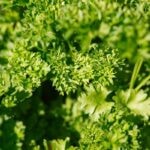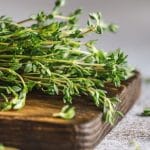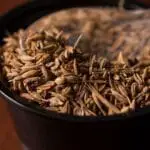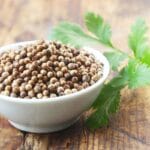In a nutshell: The dill alternatives include fennel fronds, basil (especially anise basil), tarragon, parsley, chervil, thyme, caraway seeds, anise seeds, etc. Each substitute is described with its recommended uses and flavor profiles.
Dill is known for its thin wispy leaves and pronounced anise taste. It is synonymous with pickles and potato salads. The herb is especially popular in Mediterranean cooking but is available worldwide.
Fresh dill fronds don’t last very long. Dried dill is a little more shelf-stable, while dill seeds are generally used as a spice.
If your recipe calls for dill and it is not something you usually keep around, there’s no need to run to the store.
In this guide, we’ll help you choose an easy substitute for dill weed and dried dill from something you might already have in the pantry for an equally delicious dish.
What Is Dill?
You will probably recognize the flavor of dill in popular foods like ranch dressing, tzatziki sauce, pickles, egg dishes, and potato salads.
The leaves are also called dill weed and have a flavor reminiscent of aniseed. The seeds grow in flat, oval-shaped fruits and taste similar to caraway. Due to its strong taste, it is generally used in small quantities.
Fresh or dried dill can be used interchangeably; however, the quantities will need to be adjusted. If your recipe calls for a tablespoon of fresh dill, you only need to use one teaspoon of the dried version and vice versa. Dried herbs have a concentrated flavor since all the moisture has been removed.
Easy Alternatives to Dill You Can Try
#1. Fennel Fronds
Fennel fronds resemble dill, with thin feathery green stands growing in small bunches. This makes them an excellent choice to substitute fresh dill as a garnish. They have a mild sweet licorice flavor.
With similar flavor notes, appearance, and texture, fennel fronds can, however, be used in equal quantities in any dish where you need a replacement.
See more: I don’t like fennel what can I use instead?
#2. Basil
Fresh basil has much bigger leaves and a completely different appearance and texture. It is, however, very aromatic and is also a popular Mediterranean herb.
Although you could use any type of basil, licorice or anise basil will give you similar flavor notes. The flowers and leaves of licorice basil can be eaten.
Other types of basil will lack the anise flavor but offer a slight pepperiness, sweetness, touch of bitterness, or hints of mint, cinnamon, or lemon.
Basil can be used successfully in meat and poultry dishes, as well as with vegetables, salads, sandwiches, and pasta.
#3. Tarragon
Although tarragon looks very different with its oblong dark green leaves, it has a background anise flavor that works well in similar dishes. It also has a hint of citrus and slight pepperiness.
When you substitute tarragon for dill, start by using less and slowly add to taste if needed. Fresh tarragon is generally preferred, but if you only have the dried version, you can use that too. Use only one teaspoon of dried tarragon to replace a tablespoon of fresh herbs.
Fresh leaves should always be added towards the end of the cooking process.
Tarragon pairs well with eggs, potatoes, seafood dishes, poultry, and vegetables.
Related: Substitute for dried tarragon
#4. Parsley
Parsley is an incredibly versatile herb and can be used fresh or dried. The two main types of fresh parsley are curly leaf parsley and flat leaf parsley.
Both types are suitable to use as a dill substitute and are especially good replacements with potato and fish dishes.
Parsley can be used as a garnish, in salads, or in cooked meals and pairs well with a range of Mediterranean dishes, including meat, poultry, stews, casseroles, soup, stock, and sauces.
See more: What can I use instead of parsley?
#5. Chervil
Chervil is from the same family as parsley and is also referred to as French parsley. It has a milder flavor than regular parsley and looks similar to the flat-leaf variety.
Although it does not offer the same taste or appearance as dill, it pairs well with the same types of dishes. It can be chopped and served with potatoes, omelets, scrambled eggs, fish, salads, and as part of poultry stuffing. It is also ideal for soups, sauces, and salad dressings.
#6. Thyme
Thyme has a much more earthy, savory, and peppery taste which makes it best used in recipes where you only need a background flavor.
Thyme is quite easy to find, dried or fresh in most stores. It pairs well with hearty cooked dishes such as beef recipes, lamb, poultry, pasta, fish, and root vegetables.
Related: What can you use instead of thyme?
Best Replacement for Dill Seed
#7. Caraway Seeds
Caraway seeds come from a plant in the parsley family and are used in a wide range of recipes, from rye bread and sausages to curries, soup, and vegetable dishes.
It makes a good substitute when cooking cabbage and in cream-based soups since it has a similar mild licorice taste with bittersweet hints of citrus and pepper.
You can use caraway seeds in equal quantities. Its versatility also makes it ideal to use in pickles, meat rubs, stews, and salads.
Related: Alternative to caraway seeds
#8. Anise Seeds
Anise seeds have a fairly pungent flavor profile which licorice fans will love. If you don’t like licorice, you may want to opt for a different alternative.
Anise has a sweet licorice taste that is stronger than that of fennel seeds. The greenish brown seeds are used in baking, Indian recipes, meat rubs, pickles, and salad.
Since they have a strong flavor that can easily overpower other flavors in your dish, use slightly less than your recipe calls for and add to taste if necessary.
#9. Celery Seeds
Celery seeds, unsurprisingly, have a taste very similar to that of celery stalks. Although they are earthy with a slight grassy taste and a similar depth of flavor, they don’t have the characteristic anise flavor. Celery seeds can be used in equal amounts.
#10. Dried Dill Weed
Instead of using the feathery fronds or seeds, dried dill weed is a combination of dried and finely crushed plant stems, flowers, and dill leaves.
Use it in cooked recipes such as stews and soups. It is best to add it at the same time as all the other ingredients, so the flavors have time to infuse, and the dried herbs soften and blend with other ingredients.
See more: How to dry fresh dill
#11. Oregano
Oregano is popular in Italian cooking but is also common in other Mediterranean dishes. It doesn’t have licorice accents but instead has a deep savory flavor that goes well with tomato-based recipes.
If you are trying to avoid the anise taste, this is a great dill alternative to use when cooking meat as well as in marinades, salad dressings, soups, and stews.
FAQs
How long does fresh dill last?
The fresh dill can last up to two weeks, when wrapped in a paper towel and stored in the crisper drawer of the refrigerator.
Can I use mint instead of dill?
You can use mint instead of dill, although they are not quite the same. Mint will bring a bright pop of flavor to your dish. It can be used as a substitute in yogurt-based dressings and dips as well as in recipes that feature lemon. It does not pair well with Indian flavors so stick to Mediterranean cuisine and Middle Eastern recipes when substituting with mint.
Is dill easy to grow?
Yes, dill is easy to grow. You can grow your own dill plant at home in the garden or even on the kitchen window sill. It is commonly available at many home improvement stores, garden centers, or even grocery stores. You can also dry your own dill for future use.
Is coriander similar to dill?
No, coriander is not similar to dill. Coriander and dill are distinct herbs with different flavors. Coriander has a citrusy and slightly spicy taste, while dill offers a fresh, grassy flavor with hints of anise. They are not very similar in taste but can complement each other in various dishes.
Conclusion
Fresh dill weed has a unique flavor that is hard to match. When choosing the best substitute for your dish, consider whether the distinct flavor of licorice is important or whether you simply need a dill replacement to add flavor and brightness.
If the flavor plays a significant role in your recipe, your best bet is fennel, anise seeds, or caraway seeds. If you need a garnish only, try parsley, mint, or chervil.
Basil, tarragon, and thyme, on the other hand, can bring brightness and depth, although the flavor profile of your dish will not be quite the same.
Make sure the herb you choose compliments the other flavors in your dish, and consider whether it has a stronger flavor, mild flavor, or delicate flavor when adding it to your recipe.









